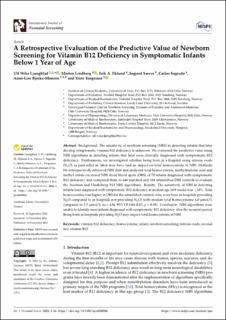| dc.contributor.author | Ljungblad, Ulf Wike | |
| dc.contributor.author | Lindberg, Morten | |
| dc.contributor.author | Eklund, Erik A. | |
| dc.contributor.author | Sæves, Ingjerd | |
| dc.contributor.author | Sagredo, Carlos | |
| dc.contributor.author | Monsen, Anne-Lise Bjørke | |
| dc.contributor.author | Tangeraas, Trine | |
| dc.date.accessioned | 2023-05-09T11:04:25Z | |
| dc.date.available | 2023-05-09T11:04:25Z | |
| dc.date.created | 2022-12-21T13:51:21Z | |
| dc.date.issued | 2022 | |
| dc.identifier.citation | International Journal of Neonatal Screening (IJNS). 2022, 8 (4), . | en_US |
| dc.identifier.uri | https://hdl.handle.net/11250/3067267 | |
| dc.description.abstract | Background: The sensitivity of newborn screening (NBS) in detecting infants that later develop symptomatic vitamin B12 deficiency is unknown. We evaluated the predictive value using NBS algorithms in detecting infants that later were clinically diagnosed with symptomatic B12 deficiency. Furthermore, we investigated whether being born in a hospital using nitrous oxide (N2O) as pain relief in labor may have had an impact on total homocysteine at NBS. Methods: We retrospectively retrieved NBS data and analyzed total homocysteine, methylmalonic acid and methyl citrate on stored NBS dried blood spots (DBS) of 70 infants diagnosed with symptomatic B12 deficiency and compared them to 646 matched and 434 unmatched DBS controls to evaluate the Austrian and Heidelberg B12 NBS algorithms. Results: The sensitivity of NBS in detecting infants later diagnosed with symptomatic B12 deficiency at median age 10.9 weeks was ≤10%. Total homocysteine was higher in DBS for the unmatched controls who were born in hospitals providing N2O compared to in hospitals not providing N2O, with median total homocysteine 4.0 µmol/L compared to 3.5 µmol/L (n = 434, 95% CI 0.04-0.87, p = 0.03). Conclusion: NBS algorithms were unable to identify most infants diagnosed with symptomatic B12 deficiency after the neonatal period. Being born in hospitals providing N2O may impact total homocysteine at NBS. Keywords: homocysteine; infant; newborn screening; nitrous oxide; second-tier; vitamin B12; vitamin B12 deficiency. © 2022 by the authors. Licensee MDPI, Basel, Switzerland. This article is an open access article distributed under the terms and conditions of the Creative Commons Attribution (CC BY) license (https:// creativecommons.org/licenses/by/ 4.0/). | en_US |
| dc.language.iso | eng | en_US |
| dc.publisher | MDPI | en_US |
| dc.relation.uri | https://www.mdpi.com/2409-515X/8/4/66 | |
| dc.rights | Navngivelse 4.0 Internasjonal | * |
| dc.rights.uri | http://creativecommons.org/licenses/by/4.0/deed.no | * |
| dc.subject | homocysteine; | en_US |
| dc.subject | infant; | en_US |
| dc.subject | newborn screening; | en_US |
| dc.subject | nitrous oxide; | en_US |
| dc.subject | second-tier; | en_US |
| dc.subject | vitamin B12; | en_US |
| dc.subject | vitamin B12 deficiency; | en_US |
| dc.title | A Retrospective Evaluation of the Predictive Value of Newborn Screening for Vitamin B12 Deficiency in Symptomatic Infants Below 1 Year of Age | en_US |
| dc.title.alternative | A Retrospective Evaluation of the Predictive Value of Newborn Screening for Vitamin B12 Deficiency in Symptomatic Infants Below 1 Year of Age | en_US |
| dc.type | Peer reviewed | en_US |
| dc.type | Journal article | en_US |
| dc.description.version | publishedVersion | en_US |
| dc.rights.holder | Copyright: © 2022 by the authors. Licensee MDPI, Basel, Switzerland. This article is an open access article distributed under the terms and conditions of the Creative Commons Attribution (CC BY) license (https:// creativecommons.org/licenses/by/ 4.0/). | en_US |
| dc.source.pagenumber | 11 | en_US |
| dc.source.volume | 8 | en_US |
| dc.source.journal | International Journal of Neonatal Screening (IJNS) | en_US |
| dc.source.issue | 4 | en_US |
| dc.identifier.doi | 10.3390/ijns8040066 | |
| dc.identifier.cristin | 2096358 | |
| cristin.ispublished | true | |
| cristin.fulltext | original | |
| cristin.qualitycode | 1 | |

